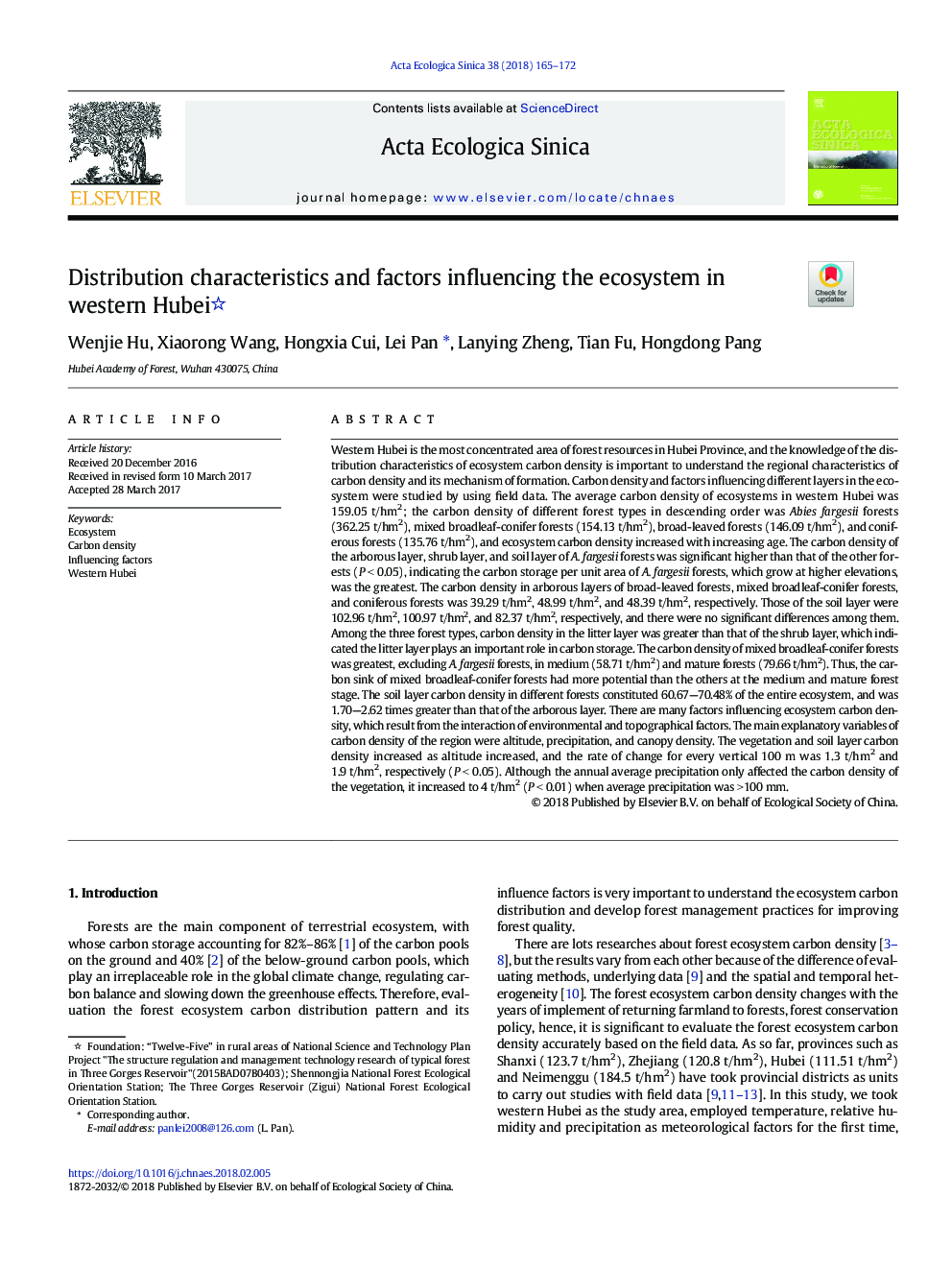| کد مقاله | کد نشریه | سال انتشار | مقاله انگلیسی | نسخه تمام متن |
|---|---|---|---|---|
| 8846322 | 1617669 | 2018 | 8 صفحه PDF | دانلود رایگان |
عنوان انگلیسی مقاله ISI
Distribution characteristics and factors influencing the ecosystem in western Hubei
ترجمه فارسی عنوان
ویژگی های توزیع و عوامل موثر بر اکوسیستم در غرب هوبئی
دانلود مقاله + سفارش ترجمه
دانلود مقاله ISI انگلیسی
رایگان برای ایرانیان
کلمات کلیدی
زیست بوم، چگالی کربن، عوامل تاثیرگذار، هوبئی غربی،
موضوعات مرتبط
علوم زیستی و بیوفناوری
علوم کشاورزی و بیولوژیک
بوم شناسی، تکامل، رفتار و سامانه شناسی
چکیده انگلیسی
Western Hubei is the most concentrated area of forest resources in Hubei Province, and the knowledge of the distribution characteristics of ecosystem carbon density is important to understand the regional characteristics of carbon density and its mechanism of formation. Carbon density and factors influencing different layers in the ecosystem were studied by using field data. The average carbon density of ecosystems in western Hubei was 159.05Â t/hm2; the carbon density of different forest types in descending order was Abies fargesii forests (362.25Â t/hm2), mixed broadleaf-conifer forests (154.13Â t/hm2), broad-leaved forests (146.09Â t/hm2), and coniferous forests (135.76Â t/hm2), and ecosystem carbon density increased with increasing age. The carbon density of the arborous layer, shrub layer, and soil layer of A. fargesii forests was significant higher than that of the other forests (PÂ <Â 0.05), indicating the carbon storage per unit area of A. fargesii forests, which grow at higher elevations, was the greatest. The carbon density in arborous layers of broad-leaved forests, mixed broadleaf-conifer forests, and coniferous forests was 39.29Â t/hm2, 48.99Â t/hm2, and 48.39Â t/hm2, respectively. Those of the soil layer were 102.96Â t/hm2, 100.97Â t/hm2, and 82.37Â t/hm2, respectively, and there were no significant differences among them. Among the three forest types, carbon density in the litter layer was greater than that of the shrub layer, which indicated the litter layer plays an important role in carbon storage. The carbon density of mixed broadleaf-conifer forests was greatest, excluding A. fargesii forests, in medium (58.71Â t/hm2) and mature forests (79.66Â t/hm2). Thus, the carbon sink of mixed broadleaf-conifer forests had more potential than the others at the medium and mature forest stage. The soil layer carbon density in different forests constituted 60.67-70.48% of the entire ecosystem, and was 1.70-2.62 times greater than that of the arborous layer. There are many factors influencing ecosystem carbon density, which result from the interaction of environmental and topographical factors. The main explanatory variables of carbon density of the region were altitude, precipitation, and canopy density. The vegetation and soil layer carbon density increased as altitude increased, and the rate of change for every vertical 100Â m was 1.3Â t/hm2 and 1.9Â t/hm2, respectively (PÂ <Â 0.05). Although the annual average precipitation only affected the carbon density of the vegetation, it increased to 4Â t/hm2 (PÂ <Â 0.01) when average precipitation was >100Â mm.
ناشر
Database: Elsevier - ScienceDirect (ساینس دایرکت)
Journal: Acta Ecologica Sinica - Volume 38, Issue 2, April 2018, Pages 165-172
Journal: Acta Ecologica Sinica - Volume 38, Issue 2, April 2018, Pages 165-172
نویسندگان
Wenjie Hu, Xiaorong Wang, Hongxia Cui, Lei Pan, Lanying Zheng, Tian Fu, Hongdong Pang,
